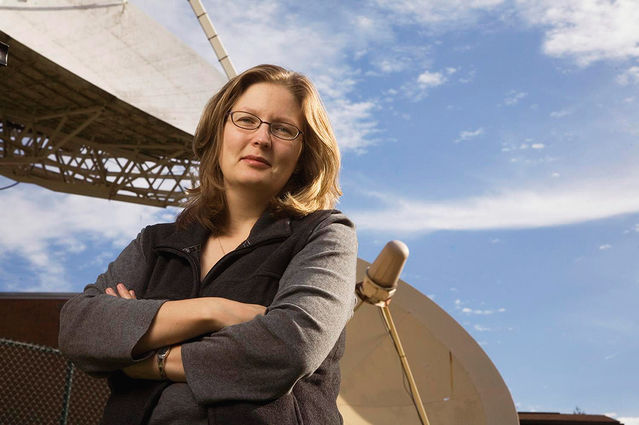Nothing to See Here
Astronomers like Kelsey Johnson rely on dark skies to peer into the history of the universe. Unfortunately, she says, we’re losing darkness at an alarming rate.
By Gary Drevitch published February 7, 2020 - last reviewed on March 3, 2020

All around the world tonight, people will look up into the sky and see...nothing. Over-illumination of cities and towns has deprived billions of their view of the stars, not to mention threatening the food chain and our health. University of Virginia astronomer Kelsey Johnson, who relies on dark skies to study light from the early moments of the universe, is fighting to preserve dark skies, and her field, for the next generation.
How has our relationship with the night sky changed?
Before the industrial revolution, you could see something magnificent and mind-blowing every night. When we didn’t have the forms of entertainment that keep us inside today, people hung around the campfire, looked at the night sky, and told stories. In modern astronomy, we use constellations with names that the Greeks came up with: They looked up and saw soap operas with colorful characters and moral lessons. Today, in urban and suburban areas, there’s no such existential experience to be had.
How does that loss affect us?
We can lose a sense that we’re part of something unfathomably large, a perspective that can deeply feed into our worldview. Religion and astronomy went together for a very long time, partly because we have a need to feel that we’re part of something, and being awestruck by the universe can give us that. And if we’re the only sentient beings in the universe capable of trying to understand it, that’s a huge ethical responsibility.
Do lighter skies affect other animals?
The impact has been studied in over a hundred species, and effects have been found in virtually every one, including humans. One small example are dogwhelks. These sea snails are an important part of coastal ecosystems. They’re the dominant invertebrate predator, even though they move at, like, a millimeter an hour. They’re also prey for crabs and birds. When dogwhelks are subjected to light at night, they’re twice as likely to stay in the water, even if a predator is around, so they’re easy pickings. When lighter skies help destroy a population of sea snails that don’t move more than 10 meters a year, you’ve lost that part of the ecosystem for decades. The cascade effects feed into the rest of the food chain.
How are satellites part of the problem?
Companies—Space X is the largest—have been given approval to launch over 12,000 new satellites into low earth orbit, all reflecting sunlight. And there may yet be approval for 30,000 more. For comparison, the number of stars you can see with the naked eye is about 6,000.
So we won’t be seeing stars; we’ll be seeing satellites?
Tens of thousands of them. The vast majority of what you’re going to see won’t be stars. And for research, it’s a nightmare. In our observations now, we can take major satellites like the International Space Station into account—their numbers are relatively small, and we know their precise orbits. But when there are 40,000, we will not be able to avoid them.
So, just as we’ve advanced our capabilities to perceive light from the dawn of history, we’ve put up a blockade.
And the real awfulness is the effect of those satellites on the invisible spectrum. Our eyes have evolved to detect a very narrow range of light, so there’s a lot of light that people don’t really pay attention to. But these satellites beam information back down to earth with invisible light that is so strong that, for our equipment, it’s going to be like looking at the sun and trying to see a birthday candle behind it. Some of this invisible light has been coming across the cosmos for 10 billion years, and now, when it finally makes it to us, it gets swamped by a satellite flooding radio waves back to Earth. The use of these invisible wavelengths is being auctioned off to the highest bidder, and that’s never going to be science.
Most children don’t study astronomy. You’ve launched a program, Dark Skies, Bright Kids, to try to address that.
If you’ve never seen stars, and you don’t learn astronomy in school, there’s a big gap there. And that means a gap in future advocates for this work. Our national science standards are thin and anemic. But astronomy can be a gateway science. Black holes, supernovas, extraterrestrial life—there’s something magical about it that can get kids fascinated. I think it all comes back to the importance of awe.
Why did you launch the program in rural areas first?
In part because they actually have dark skies, but also because they’re radically underserved. I want to help them tap into this amazing natural resource in their backyard that’s totally free and help them see dark skies as an asset. But even for kids who live in cities with planetariums, the experience should be more than three-dimensional: To feel the air and hear the insects around, that’s different from being in an enclosed planetarium.
